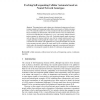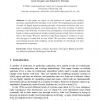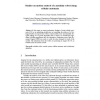16 search results - page 1 / 4 » Using cellular automata and gradients to control self-reconf... |
RAS
2006
13 years 4 months ago
2006
Self-reconfigurable robots are built from modules, which are autonomously able to change the way they are connected. Such a robot can, through this self-reconfiguration process, c...
SASO
2008
IEEE
13 years 11 months ago
2008
IEEE
—When programming a spatial computing medium such as a cellular automaton, the hop count distance to some set of sources (particles) is an often used information. In particular, ...
IWSOS
2011
Springer
12 years 7 months ago
2011
Springer
Abstract This paper depicts and evaluates an evolutionary design process for generating a complex self-organizing multicellular system based on Cellular Automata (CA). We extend th...
EVOW
2010
Springer
13 years 9 months ago
2010
Springer
In this paper we report on the synthesis of sounds using cellular automata, specifically the multitype voter model. The mapping process adopted is based on digital signal processin...
AUSAI
2006
Springer
13 years 8 months ago
2006
Springer
Abstract. In this paper we report preliminary findings of using cellular automata (CA) as an underlying architecture in controlling the motion of a fivelegged brittle star typed ro...



